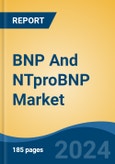Point Of Care Testing is the fastest growing segment, North America is the largest market globally
Speak directly to the analyst to clarify any post sales queries you may have.
10% Free customizationThis report comes with 10% free customization, enabling you to add data that meets your specific business needs.
Key Market Drivers
The growth of the Global BNP and NTproBNP Market is significantly influenced by the escalating prevalence of cardiovascular diseases and the expanding geriatric population increasingly susceptible to heart conditions. The rising incidence of cardiovascular diseases necessitates widespread diagnostic and prognostic tools like BNP and NTproBNP assays for early detection and disease management. According to the World Health Organization, in 2022, an estimated 19.8 million people died from cardiovascular diseases, highlighting the profound global health burden these conditions impose. Concurrently, the increasing longevity of populations worldwide contributes to a higher prevalence of age-related cardiac ailments. This demographic shift directly fuels demand for cardiac biomarkers.Key Market Challenges
The inherent limited specificity of Brain Natriuretic Peptide and N-terminal pro-B-type Natriuretic Peptide tests significantly impedes market expansion. Elevated levels of these biomarkers can arise from various non-cardiac conditions, such as renal failure and pulmonary embolism, potentially leading to false-positive diagnoses and complicating clinical interpretation. This lack of singular diagnostic clarity diminishes confidence in the tests as standalone indicators for heart failure.Key Market Trends
The expanding integration of point-of-care (PoC) testing represents a significant trend in the global BNP and NTproBNP market by decentralizing diagnostic capabilities and enabling rapid clinical decisions. PoC devices provide immediate results, crucial for managing acute cardiac events and enhancing patient throughput in emergency settings. This trend reflects a broader move towards more accessible and efficient diagnostic pathways. For instance, the American College of Cardiology in a journal scan from August 2024, highlighted a 2-hour strategy for point-of-care high-sensitivity cardiac troponin I testing in suspected acute myocardial infarction, underscoring the drive for expedited cardiac biomarker assessment.Key Market Players Profiled:
- Specim, Spectral Imaging Ltd
- Gentian Diagnostics ASA
- Siemens AG
- PerkinElmer Inc
- Biomerieux SA
- Quidel Corporation
- Bio-Rad Laboratories, Inc.
- F. Hoffman-La Roche Ltd
- BHR Pharmaceuticals Ltd.
- Xiamen Biotime Biotechnology Co., Ltd.
Report Scope:
In this report, the Global BNP And NTproBNP Market has been segmented into the following categories:By Type:
- Brain Natriuretic Peptide
- NT-proBNP (N-terminal Pro-B-Type Natriuretic Peptide)
By Location of Testing:
- Point Of Care Testing
- Laboratory Testing
By Application:
- Myocardial Infarction
- Congestive Heart Failure
- Acute Coronary Syndrome (ACS)
- Others
By Region:
- North America
- Europe
- Asia Pacific
- South America
- Middle East & Africa
Competitive Landscape
Company Profiles: Detailed analysis of the major companies present in the Global BNP And NTproBNP Market.Available Customizations:
With the given market data, the publisher offers customizations according to a company's specific needs. The following customization options are available for the report:- Detailed analysis and profiling of additional market players (up to five).
This product will be delivered within 1-3 business days.
Table of Contents
Companies Mentioned
- Specim, Spectral Imaging Ltd
- Gentian Diagnostics ASA
- Siemens AG
- PerkinElmer Inc
- Biomerieux SA
- Quidel Corporation
- Bio-Rad Laboratories, Inc.
- F. Hoffman-La Roche Ltd
- BHR Pharmaceuticals Ltd.
- Xiamen Biotime Biotechnology Co., Ltd.
Table Information
| Report Attribute | Details |
|---|---|
| No. of Pages | 185 |
| Published | November 2025 |
| Forecast Period | 2024 - 2030 |
| Estimated Market Value ( USD | $ 1.92 Billion |
| Forecasted Market Value ( USD | $ 2.91 Billion |
| Compound Annual Growth Rate | 7.1% |
| Regions Covered | Global |
| No. of Companies Mentioned | 10 |









